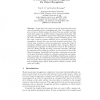Free Online Productivity Tools
i2Speak
i2Symbol
i2OCR
iTex2Img
iWeb2Print
iWeb2Shot
i2Type
iPdf2Split
iPdf2Merge
i2Bopomofo
i2Arabic
i2Style
i2Image
i2PDF
iLatex2Rtf
Sci2ools
ECCV
1998
Springer
1998
Springer
A Two-Stage Probabilistic Approach for Object Recognition
Assume that some objects are present in an image but can be seen only partially and are overlapping each other. To recognize the objects, we have to rstly separate the objects from one another, and then match them against the modeled objects using partial observation. This paper presents a probabilistic approach for solving this problem. Firstly, the task is formulated as a two-stage optimal estimation process. The rst stage, matching, separates di erent objects and nds feature correspondences between the scene and each potential model object. The second stage, recognition, resolves inconsistencies among the results of matching to di erent objects and identi es object categories. Both the matching and recognition are formulated in terms of the maximum a posteriori (MAP) principle. Secondly, contextual constraints, which play an important role in solving the problem, are incorporated in the probabilistic formulation. Speci cally, between-object constraints are encoded in the prior distr...
Computer Vision | Di Erent Objects | ECCV 1998 | Jigsaw Objects | Markov Random Eld | Modeled Objects | Two-stage Optimal Estimation |
Related Content
| Added | 16 Oct 2009 |
| Updated | 16 Oct 2009 |
| Type | Conference |
| Year | 1998 |
| Where | ECCV |
| Authors | Stan Z. Li, Joachim Hornegger |
Comments (0)

